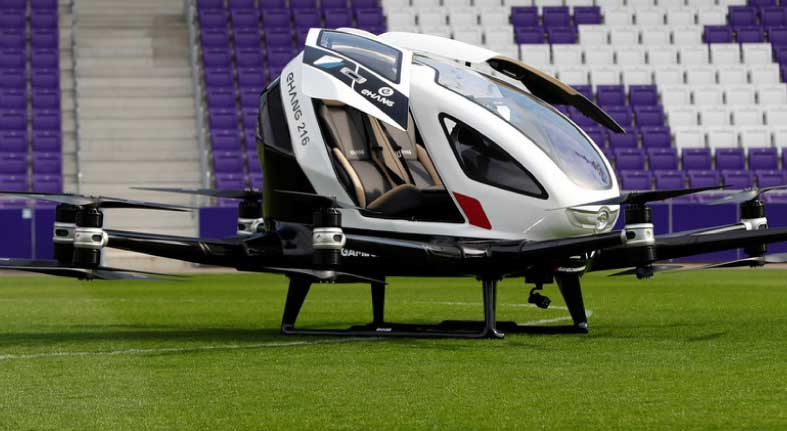Urban Aerial Mobility – the movement of goods and people through the skies – has long been a focus for city builders, policymakers, engineers and urban designers trying to understand how unlocking the elusive third dimension of transportation could positively transform people’s lives.
- Flying taxis and drones could cut traffic congestion in cities
- Traffic jams cost every US driver $1,348 last year
- Urban aerial mobility needs to be available to all, not the elite
- In the last two years there have been breakthroughs in the tech
Might Urban Aerial Mobility be the key to reducing congestion, removing people and packages off roads?
Might it enable more people to access well-paid jobs, or will it induce urban sprawl?
How might the addition of flying vehicles such as taxis and drones affect noise, the environment, even our cityscapes and city views?
And could it be accessible to all, regardless of income or neighborhood?
These questions sit at the center of policymaking decisions as new technologies with the potential to transform the organization of urban life emerge – and as it becomes more difficult to address the growth of cities and congestion with traditional infrastructure investments.
Around the world, gridlock is draining economies and human potential. Congestion cost drivers in the United States more than $87 billion in 2018, according to the INRIX Global Traffic Scorecard, an average of $1,348 per driver. Emerging economies are the most affected, with Russia, Turkey, Colombia, Mexico and Brazil ranked the top five most-gridlocked nations. Increasingly, policymakers are grappling with the use of the third dimension as an important part of a multi-modal network to reverse gridlock even as more people and jobs locate in metropolitan areas.

Urban flight is not new. VIPs have been using helicopters in cities for decades, leading to a stigma that low-altitude aviation is only accessible to the rich and famous – and with a high cost to our carbon footprint and emissions.
In the past two years, however, developments by the private sector have been challenging that assumption. We see new air operators, new models of service and a new focus on electric vertical take-off and landing (EVTOL) and autonomous flight, which could make 80% of helicopter accident causes obsolete. Safer transport and cleaner mobility are vital to the successful growth of cities. In recent models comparing distances, passenger load and energy consumption, an EVTOL aircraft outperformed even an electric car for distances further than 62 miles.
By supplementing existing transportation networks and providing accessible service by air, Urban Aerial Mobility could be a core component of future urban mobility. However, affordability requires scale. Uber Elevate set a goal to reduce the cost of aerial taxi ridesharing to $0.44 per passenger mile (compared to $0.464 per mile to drive your own car) but it’s unclear whether this can be achieved, given current understanding of both the challenges and opportunities of operating more vehicles in the sky.
Making urban flight a reality
The future of aerial mobility will of course rely on advances in technology that are just beginning to take shape today.
Vehicles must meet a certifiable safety threshold from regulators. Given Moore’s Law and the steep slope of technology adoption curves, so many in the aviation community believe it’s time for policymakers and companies to collaborate and ensure tech developments and deployments and government processes mature along the same timeline.
For example, Uber, which wants to become the platform to connect air taxi services, has set a timeline to operate their first commercial urban air taxis by 2023. Volocopter, a German-based UAM company, recently unveiled the world’s first air taxi vertiport in Singapore for completely autonomous flight testing. Airbus, a global leading aviation manufacturer, has invested extensively in multiple UAM projects, including Vahana (a one-passenger EVTOL platform), Voom (on-demand helicopter booking platform) and City Airbus (a four-passenger EVTOL platform). The company sees the increasing congestion and trend of urbanization as a catalyst for sustainable transportation in urban environments.
Regardless of the maturity of technology, it will take more than just technologists and urban planners to make Urban Aerial Mobility a meaningful and impactful part of cities’ future transportation networks.
As Jonathan Hartman, Disruptive Technologies Lead for Lockheed Martin’s Sikorsky Innovations’ group explains, “We need to be talking about this in a more systematic way. This includes reaching out beyond aerospace and to others we don’t normally interact with. I don’t know the last time an elevator company talked to a helicopter company, but that’s exactly what we’re doing.”
Sikorsky is developing enabling technologies to help make urban mobility a reality, including electric propulsion, autonomy and fleet management. But as Hartman will tell you, “Sikorsky fundamentally believes that the environment that these vehicles will operate in will be just as important as the vehicle itself.”
For Urban Aerial Mobility to become a reality, we’ll need to bring together policymakers at all levels, to talk about decision points that haven’t ever been considered, and to assess the impact on a scale and timeframe unique to the Fourth Industrial Revolution.
Startups in Los Angeles are investing heavily in urban aviation to create new modes of efficient and safe transportation in one of the most congested cities in the world. Skyryse, for example, is focused on developing community-friendly air transportation infused with cutting-edge technology. Mark Groden, CEO of Skyryse, explains, “Our goal is to democratize the air, and there’s no better place to start than in Los Angeles, the heart of aerospace innovation. As an industry co-chair of the Urban Aerial Mobility Working Group, we look forward to sharing our vision for our transportation future.”


